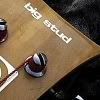Does the polar pattern of the mic tell anything about how far in each direction of the mic it collects information?
Are there mics or types of that are renowned for being able to reach in front of them with more depth? Is this mostly a function of a hyper- or supercardioid pattern?
My cardioid AT4040 seemed to have a wide bloom of a pattern but not much reach, if I'm using the right terminology. Let's say I was using it to record a guitar amp tilted back on a folding chair. Sitting up in standard position, it would pick up a lot of room noise from my floor and ceiling but if I turned it facing the floor, it would give the impression of a much bigger room. Beyond 3' or so in front of it, it doesn't capture anything interesting.
My supercardioid 441 can be pointed at a source a couple of yards down a hallway and get some really interesting texture without picking up unpleasant, useless vibes from the floor and ceiling. Except for vocals, it's almost better a couple of feet or more away from a source.
If I'm looking for mics as I describe, like the 441, are there other common terms that describe what I'm talking about?
This is the kind of thing I think about. I hope it makes sense.
reach & spread of a mic relevant to the polar pattern?
-
Theo_Karon
- pushin' record
- Posts: 208
- Joined: Mon Dec 15, 2008 6:19 am
- Location: Los Angeles
- Contact:
The type of mic has no effect whatsoever on how far it can hear; this is a common misconception. No mic can magically ignore or 'reach' to pick up sounds that are farther away from the mic. Put a 57 up next to a cardioid condenser and crank the gain on the 57 until the levels are matched; the 57 will pick up just as much room sound as the condenser, this is just not how it's typically used. The only reason that your hypercardioid mic is picking up less extraneous information is because of its very narrow, focused pickup pattern.
Just in case I'm not being clear (that last paragraph seems a little confusing), think of it this way. If you have an omni condenser and a cardioid dynamic at the same spot in a room, and you have someone playing acoustic guitar 20 feet away directly in front of the dynamic mic, assuming levels are matched both mics will pick up the same amount of direct sound from the guitar, no matter how far away it is, as long as it stays right in the center of the cardioid mic's pickup pattern. The omni will pick up a lot more room sound, which isn't because it hears sounds that are farther away better, but because it's picking up a lot of the reflections that the cardiod mic rejects.
Hope this helped.
Just in case I'm not being clear (that last paragraph seems a little confusing), think of it this way. If you have an omni condenser and a cardioid dynamic at the same spot in a room, and you have someone playing acoustic guitar 20 feet away directly in front of the dynamic mic, assuming levels are matched both mics will pick up the same amount of direct sound from the guitar, no matter how far away it is, as long as it stays right in the center of the cardioid mic's pickup pattern. The omni will pick up a lot more room sound, which isn't because it hears sounds that are farther away better, but because it's picking up a lot of the reflections that the cardiod mic rejects.
Hope this helped.
- Scodiddly
- genitals didn't survive the freeze
- Posts: 3992
- Joined: Wed Dec 10, 2003 6:38 am
- Location: Mundelein, IL, USA
- Contact:
What Theo said, plus...
It's important to also look at pickup pattern over frequency. Most mics are fairly directional at higher frequencies but less directional at lower frequencies. That's one of the big things about LDC mics - they're practically omni at lower frequencies. Some mics, such as SDC mics from Earthworks or the famed Sennheiser 441, are much more consistent in having the same pickup pattern over the full frequency range.
Sloppy specs and documentation can confuse this issue significantly.
It's important to also look at pickup pattern over frequency. Most mics are fairly directional at higher frequencies but less directional at lower frequencies. That's one of the big things about LDC mics - they're practically omni at lower frequencies. Some mics, such as SDC mics from Earthworks or the famed Sennheiser 441, are much more consistent in having the same pickup pattern over the full frequency range.
Sloppy specs and documentation can confuse this issue significantly.
- thunderboy
- buyin' a studio
- Posts: 993
- Joined: Wed May 07, 2003 11:53 am
- Location: ROC, NY, USA
- @?,*???&?
- on a wing and a prayer
- Posts: 5804
- Joined: Wed May 07, 2003 4:36 pm
- Location: Just left on the FM dial
- Contact:
The polar pattern doesn't but the microphone operation principle does.
A dynamic mic typically has a sphere of sensitivity that is around 5' in diameter. A condenser mic has a sphere of sensitivity that is around 20' in diameter.
The explanation for this is pretty simple. A condenser mic has a diaphragm that is about 1000 times lighter than a dynamic mic. It takes less sound pressure to cause the diaphragm to move on a condenser mic.
btw, the genius of the Heil mics as dynamics is that they utilize diaphragms that are much lighter than the traditional dynamic mic. It helps their frequency response too.
A dynamic mic typically has a sphere of sensitivity that is around 5' in diameter. A condenser mic has a sphere of sensitivity that is around 20' in diameter.
The explanation for this is pretty simple. A condenser mic has a diaphragm that is about 1000 times lighter than a dynamic mic. It takes less sound pressure to cause the diaphragm to move on a condenser mic.
btw, the genius of the Heil mics as dynamics is that they utilize diaphragms that are much lighter than the traditional dynamic mic. It helps their frequency response too.
Who is online
Users browsing this forum: No registered users and 75 guests



